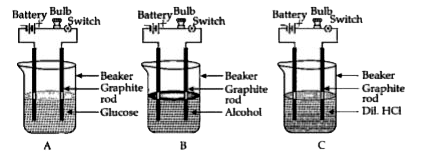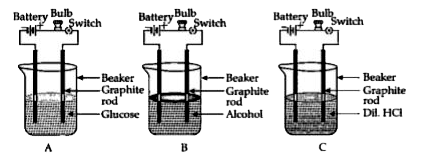Suhana takes three beakers, A, B and C filled with aqueous solutions of glucose, alcohol and hydrochloric acid repectively as shown in the following figure.

The bulb glows in a solution depending on whether the solution is:
acidic
an electrolyte
basic
a non electrolyte
The correct Answer is:B
An electrolyte is a solution that can conduct electricity due to ions present in it.
Topper's Solved these Questions
- BOOK - OSWAL PUBLICATIONCHAPTER - ACIDS, BASES AND SALTSEXERCISE - Self Assessment - 1 (I. Objective Type Questions) A. Multiple Choice Questions3videos
ACIDS, BASES AND SALTS
- BOOK - OSWAL PUBLICATIONCHAPTER - ACIDS, BASES AND SALTSEXERCISE - Self Assessment - 1 (I. Objective Type Questions) B. Passage / Table Based Questions4videos
ACIDS, BASES AND SALTS
- BOOK - OSWAL PUBLICATIONCHAPTER - ACIDS, BASES AND SALTSEXERCISE - ASSERTION AND REASON BASED MCQs8videos
ACIDS, BASES AND SALTS
- BOOK - OSWAL PUBLICATIONCHAPTER - CARBON AND ITS COMPOUNDSEXERCISE - CREATING BASED QUESTIONS23videos
CARBON AND ITS COMPOUNDS
Similar Questions
Suhana takes three beakers, A, B and C filled with aqueous solutions of glucose, alcohol and hydrochloric acid repectively as shown in the following figure.

Which of the following are present in a dilute aqueous solution of hydrochloric acid?View SolutionSuhana takes three beakers, A, B and C filled with aqueous solutions of glucose, alcohol and hydrochloric acid repectively as shown in the following figure.

Which of the following statement is correct in terms of glowing of bulb when the switch is ON?View Solution
Knowledge Check
- Question 1 - Select One
Observe the following diagram and answer any four questions from (i) and (v) given below.
During an experiment, Rehana took three beakers A, B and C filled with aqueous solutions of glucose, alcohol and hydrochloric acid respectively as shown in the following figure :

Which of the following (major ions) are present in a dilute aqueous solution of hydrochloric acid ?AH3O++Cl−BH3O++OH−CCl−+OH−DUnionized HCl - Question 2 - Select One
Observe the following diagram and answer any four questions from (i) and (v) given below.
During an experiment, Rehana took three beakers A, B and C filled with aqueous solutions of glucose, alcohol and hydrochloric acid respectively as shown in the following figure :

If the property of ion formation is considered, which of the following options is correct ?AGlucose and alcohol solutions do not conduct electricity as they do not have ions.BDil HCl contains ions so the flow of ions is responsible for the flow of current.COptions (a) and (b) both are correct.DNone of the options is correct - Question 3 - Select One
Observe the following diagram and answer any four questions from (i) and (v) given below.
During an experiment, Rehana took three beakers A, B and C filled with aqueous solutions of glucose, alcohol and hydrochloric acid respectively as shown in the following figure :

Which of the following statements is correct in terms of glowing of bulb when the switch of ON ?ABulb A and B do not glow but bulb C glows.BBulb A and C do not glow but bulb B glows.CNone of the bulb glow.DAll the bulb glow.
Suhana takes three beakers, A, B and C filled with aqueous solutions of glucose, alcohol and hydrochloric acid repectively as shown in the following figure.

Which of the following statement is true if alcohol is replaced with NaOH solution:View SolutionObserve the following diagram and answer any four questions from (i) and (v) given below.
During an experiment, Rehana took three beakers A, B and C filled with aqueous solutions of glucose, alcohol and hydrochloric acid respectively as shown in the following figure :

What change will be noticed if the content of beaker B is replaced by sodium hydroxide solution ?View SolutionObserve the following diagram and answer any four questions from (i) and (v) given below.
During an experiment, Rehana took three beakers A, B and C filled with aqueous solutions of glucose, alcohol and hydrochloric acid respectively as shown in the following figure :

Though the compounds such as glucose and alcohol have hydrogen atoms in their molecules yet they are not categorised as acids. It be because :View SolutionWhen mango is placed in dilute aqueous solution of hydrochloric acid, it?
View SolutionWhich of the following are present in a dilute aqueous solution of hydrochloric acid ?
View Solution
